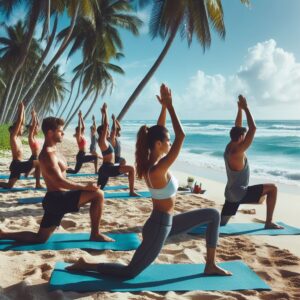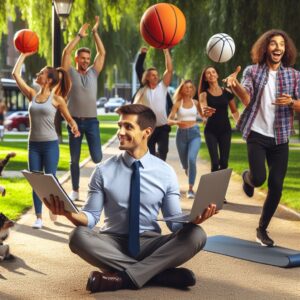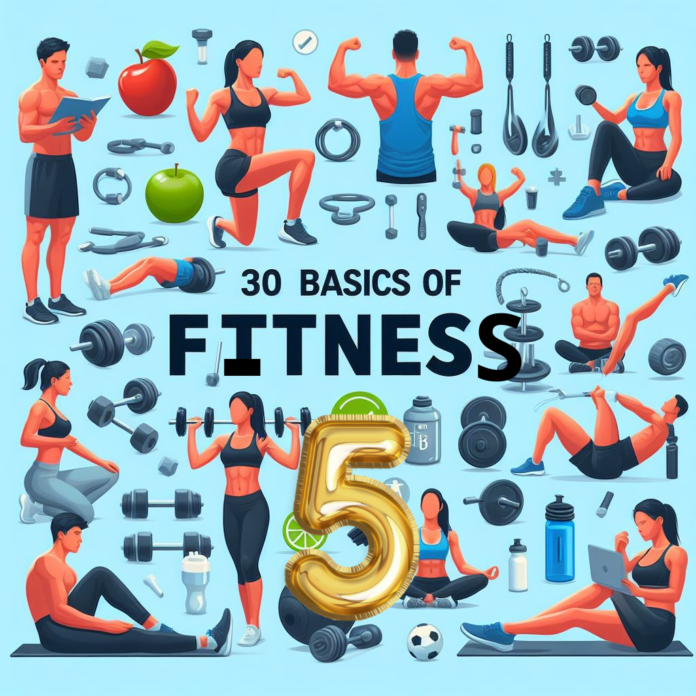By infusing your fitness routine with elements of play and exploration, you transform exercise from a mundane task into an exciting adventure. This approach not only enhances your physical well-being but also contributes to your overall happiness and satisfaction with life. Embarking on a fitness journey can often feel daunting, especially for beginners who are navigating the vast landscape of workouts, nutrition, and wellness strategies. However, understanding the foundational elements of fitness can significantly demystify this process, providing a clear path toward achieving personal health goals.
This guide, “The 30 Basics of Fitness: A Complete Guide for Beginners,” is meticulously designed to equip you with essential insights, ranging from optimizing your training environment to integrating mindfulness and play into your routines. By embracing these principles, you’ll not only enhance your physical capabilities but also enrich your overall well-being.
I. The Importance of Environment in Fitness Training:

The significance of your training environment cannot be overstated. It’s not just about the physical space; it’s about crafting an atmosphere that elevates your motivation, enhances your performance, and aligns with your personal preferences and goals. Whether it’s at home, a local park, or a bustling gym, the setting in which you exercise plays a pivotal role in your fitness journey.
1. Choosing Your Ideal Training Environment:
The first step towards optimizing your fitness routine is identifying an environment that resonates with you. This decision is deeply personal and varies from one individual to another. Some may find solace in the quiet and controlled environment of their home, where they can focus on their workout without distractions. Others might thrive in the vibrant and energetic ambiance of a gym, where the presence of fellow fitness enthusiasts fuels their motivation.
2. Home Workouts: The Sanctuary of Solitude.
For those who prefer a minimalist and serene space, home workouts offer the perfect solution. The comfort of being in your own space allows you to tailor your workout environment to your specific needs. This could mean setting up a dedicated workout room or simply designating a corner of your living room for exercise. The key is to ensure that your space is clutter-free and conducive to focusing on your fitness goals.
3. Outdoor Workouts: Merging Fitness with Nature.
Alternatively, exercising in a park or an outdoor setting introduces a refreshing change of scenery and the added benefit of fresh air. Outdoor workouts can be particularly motivating for those who enjoy being in nature. The natural landscape not only provides a stunning backdrop for your exercise routine but also offers versatility in your workouts—think running on trails, yoga under the sky, or calisthenics using park benches.
4. Gym Workouts: A Hub of Energy and Community.
For individuals who crave a dynamic and stimulating environment, joining a gym might be the right choice. Gyms are equipped with a wide range of equipment, catering to all aspects of fitness training—from cardio to strength training and everything in between. Moreover, the communal aspect of gyms can be highly motivating. Seeing others working towards their fitness goals can inspire you to push your limits. Additionally, gyms often offer classes led by professional instructors, providing an opportunity for social interaction and learning.
5. Personalizing Your Space:
No matter where you choose to exercise, personalizing your training environment can significantly impact your motivation and enjoyment. This could involve playing uplifting music that energizes you, hanging motivational posters that speak to your goals, or incorporating plants to enhance the aesthetic appeal and air quality of your space. Creating an ambiance that makes you look forward to your workout sessions is crucial.
The environment in which you train is more than just a backdrop; it’s a crucial component of your fitness journey. By carefully selecting and personalizing your training space, you can create an environment that not only supports your physical activities but also boosts your mental well-being and motivation.
II. The Power of Mentorship and Coaching in Fitness Training:

The journey to fitness is a personal and sometimes challenging endeavor. Whether you’re a beginner or an experienced athlete, the path to achieving your fitness goals can be significantly enhanced with the guidance of a mentor or personal coach. This professional guidance is not just about getting fit; it’s about transforming your approach to fitness, developing healthy habits, and optimizing your workout routine for maximum effectiveness. Let’s delve into how mentorship or coaching can revolutionize your fitness experience.
1. Tailored Guidance and Personalization:
One of the paramount benefits of having a personal coach is the tailored guidance you receive. Unlike generic fitness programs, a personal coach assesses your specific needs, strengths, and limitations. This personalized approach ensures that your training regimen is not only effective but also safe, reducing the risk of injury. A coach can help you navigate through the myriad of workout options and tailor a program that aligns with your fitness goals, whether it’s weight loss, muscle building, or improving athletic performance.
2. Motivation and Accountability:
Staying motivated is one of the biggest challenges in any fitness journey. A coach or mentor acts as a catalyst for motivation, pushing you beyond your perceived limits and encouraging you to persist even when progress seems slow. The accountability factor of regularly scheduled sessions with a coach means you’re less likely to skip workouts, ensuring consistent progress toward your goals. Furthermore, having someone who celebrates your achievements, no matter how small, can be a powerful motivator.
3. Overcoming Plateaus and Making Adjustments:
Fitness plateaus are a common frustration. A period where progress stalls can be demoralizing, but it’s here that a coach’s expertise becomes invaluable. They can analyze your current program and identify areas for improvement, whether it’s introducing new exercises, adjusting intensity, or tweaking your diet. Their external perspective can provide fresh insights into overcoming these hurdles, ensuring that you continue to advance towards your fitness objectives.
4. Emotional Support and Mentorship:
The fitness journey is as much emotional as it is physical. A coach or mentor provides not just technical support but also emotional and motivational backing. They’re there during the tough times, offering encouragement and reminding you of why you started. This emotional support can be the difference between giving up during moments of doubt or pushing through to achieve your goals.
5. Choosing the Right Coach:
Finding the right coach is crucial. This should be someone whose expertise aligns with your fitness goals and whose coaching style matches your personality. Look for certifications and experience, but also consider compatibility. A coach who understands your motivations and challenges can tailor their coaching approach accordingly.
Incorporating mentorship or coaching into your fitness regimen can be transformative. It offers a personalized, motivating, and supportive path to achieving your fitness goals. The right coach not only enhances your physical performance but also fosters a positive mindset towards fitness and health.
III. Balancing Work Life and Physical Activity:

Maintaining a balance between professional responsibilities and physical health has become a significant challenge for many. The demands of a full-time job, combined with personal commitments, can often leave little room for physical activity. However, integrating exercise into your busy schedule is crucial for your physical and mental well-being. Let’s explore some effective strategies to achieve this balance, ensuring that you stay active and healthy without compromising your professional life.
1. Optimize Your Routine with High-Intensity Workouts:
One of the most efficient ways to incorporate physical activity into a tight schedule is through high-intensity interval training (HIIT). These workouts are designed to deliver maximum benefits in minimal time, often in 30 minutes or less. HIIT sessions involve short bursts of intense activity followed by brief rest periods, making them highly effective for burning calories, building muscle, and improving cardiovascular health. The flexibility of HIIT means you can perform these workouts at home, in a park, or even in a small space at the office, making it easier to fit exercise into your day.
2. Seamless Integration: Exercise at the Office.
For those spending long hours at the office, integrating simple exercises into your workday can make a significant difference. Consider standing desks or stability balls to engage your core and improve posture throughout the day. Taking short, active breaks can also boost your energy and productivity. Simple activities like stair climbing, desk yoga, or even a quick walk around the block can help counteract the negative effects of prolonged sitting.
3. Social and Family Activities: Combining Fitness with Fun.
Incorporating physical activity into family time or social gatherings is an excellent way to stay active while also strengthening bonds with loved ones. Activities like hiking, cycling, or playing sports can be enjoyable for all ages and fitness levels. Planning active weekends or holiday activities ensures that you keep moving and avoid the sedentary lifestyle that often accompanies busy work weeks. Moreover, exercising with friends or family members creates a supportive environment, making it more likely for you to stick to your fitness goals.
4. Making Time: Schedule and Commit.
The key to balancing work and physical activity is treating your workout sessions as non-negotiable appointments. Just as you would schedule a meeting or a doctor’s appointment, block out time for your exercise routine in your calendar. This commitment helps you prioritize your health and ensures that you make time for physical activity, regardless of your workload.
5. Adapt and Overcome: Flexibility in Your Fitness Journey.
Finally, it’s important to maintain flexibility in your approach to fitness. Some days, squeezing in a full workout might be impossible; on these days, even a short walk or some stretching exercises can be beneficial. The goal is to stay active in any way possible, adapting your exercise routine to fit your daily schedule rather than sacrificing it entirely.
Balancing a busy professional life with physical activity requires creativity, commitment, and a bit of planning. By implementing these strategies, you can ensure that your health remains a priority, leading to improved performance at work, better health outcomes, and a more fulfilling life overall.
IV. Harnessing Mindfulness in Fitness:

Incorporating mindfulness into your fitness routine represents a holistic approach to health, emphasizing not just physical strength and endurance but also mental clarity and emotional resilience. mindfulness, the practice of being present and fully engaged in the moment without judgment, can significantly amplify the benefits of physical exercise by fostering a deeper connection between mind and body. This integration can lead to improved focus, reduced stress levels, and a more profound enjoyment of your fitness journey. Let’s explore how to effectively blend mindfulness with physical activity for a harmonious balance.
1. Meditation: The Foundation of Mindfulness.
Beginning or ending your workout sessions with meditation can profoundly impact your fitness experience. Meditation helps in centering your thoughts, calming your mind, and preparing your body for exercise. By meditating before your workout, you can set intentions, focus on your goals, and enter your fitness session with a clear mind. Post-exercise meditation, on the other hand, allows your body to cool down and your mind to reflect on your accomplishments, fostering a sense of gratitude and satisfaction. Even a few minutes of meditation can make a significant difference in your mental and emotional state, enhancing the overall quality of your workout.
2. Conscious Movement: The Art of Being Present.
Incorporating mindfulness into the very act of exercising focusing intently on each movement and breath can transform your workout from a routine task into a form of moving meditation. This practice, known as conscious movement, encourages you to tune into your body’s sensations, breathing patterns, and the nuances of each exercise. Whether you’re lifting weights, running, or stretching, paying close attention to your body’s movements and physical sensations can improve your form, increase the effectiveness of your workout, and reduce the risk of injury. Moreover, this heightened awareness can make your exercise more enjoyable and mentally engaging.
3. Mindful Fitness Disciplines: Yoga and Tai Chi.
Certain physical activities, like yoga and tai chi, are inherently designed to promote mindfulness. These disciplines combine physical movement with focused breathing and mental concentration, creating a holistic workout that nurtures both body and mind. Practicing yoga or tai chi can improve flexibility, balance, and strength while also enhancing mental clarity and stress resilience. The slow, deliberate movements of these practices encourage a meditative state, helping you to cultivate mindfulness and its numerous benefits naturally.
4. Practical Tips for Integrating Mindfulness into Your Fitness Routine:
-Set Intentions: Before beginning your workout, take a moment to set a clear intention. This could be a goal for the session or a broader aspiration for your fitness journey.
-Focus on Breath: Use your breath as an anchor to maintain mindfulness during your workout. Concentrating on your breathing not only helps in controlling the pace but also keeps you present.
-Embrace the Moment: Instead of rushing through your exercises, embrace each moment. Appreciate your body’s capabilities and the opportunity to engage in physical activity.
-Reflect Post-Workout: After exercising, spend a few minutes in reflection. Acknowledge your efforts, congratulate yourself on your achievements, and consider what you’ve learned about your body and mind during the session.
Incorporating mindfulness into your fitness regime is a journey that requires practice and patience. However, the rewards enhanced focus, reduced stress, and a deeper connection to your physical activities are invaluable.
V. Elevating Your Fitness Journey Through Event Participation:

Joining fitness events, from local races to international yoga retreats, can dramatically transform your fitness journey. These gatherings are not merely about competition; they’re about setting personal goals, connecting with a community, and pushing your limits in new, exciting environments. Whether you’re a seasoned athlete or a fitness enthusiast looking to spice up your routine, participating in fitness events can offer a wealth of benefits. Let’s dive into how these events can motivate you, foster learning, and provide unique opportunities to test your abilities.
1. Setting Motivational Goals:
Fitness events are excellent for setting clear, achievable goals. Preparing for a specific event, such as a marathon or a strength competition, provides a tangible target to work towards, which can significantly enhance your training focus and intensity. These goals also introduce deadlines into your fitness regimen, adding a sense of urgency and commitment to your training. As you work towards these objectives, you’ll likely discover new reserves of strength and determination, helping you to surpass your perceived limits.
2. Building Community and Finding Inspiration:
One of the most rewarding aspects of participating in fitness events is the opportunity to meet and interact with like-minded individuals. These events gather people from diverse backgrounds but with a shared passion for fitness, creating an energizing and supportive environment. Engaging with this community can inspire you, offer new insights, and foster friendships that extend beyond the event. Moreover, witnessing the achievements of others can motivate you to set higher personal standards and explore new fitness disciplines.
3. Learning Through Experience and Expertise:
Fitness events often feature workshops, seminars, and demonstrations led by experts in the field. Participating in these educational opportunities can broaden your knowledge of fitness, nutrition, and wellness. Whether it’s mastering a new yoga pose, learning about the latest training methodologies, or understanding how to enhance your diet for better performance, these learning experiences can significantly impact your fitness journey. Moreover, applying the insights and techniques learned during these events can lead to improvements in your overall health and fitness levels.
4. Testing Yourself in a New Environment:
Whether competitive or collaborative, fitness events challenge you to perform in unfamiliar settings. This can be incredibly beneficial, pushing you out of your comfort zone and testing your adaptability and resilience. For competitive individuals, events like races or strength competitions provide a platform to gauge your abilities against others, offering a clear measure of your progress. For those more inclined towards collaboration, activities like group yoga sessions or team obstacle courses emphasize collective achievement and personal growth.
5. How to Get Involved?
-Research Local and International Events: Start by looking for events that align with your interests and fitness level. Local running clubs, gym boards, and online fitness communities are great places to find information.
-Choose an Event That Excites You: Whether it’s the challenge of a triathlon, the tranquility of a yoga retreat, or the camaraderie of a team obstacle course, pick an event that genuinely appeals to you.
-Prepare Accordingly: Once you’ve registered, tailor your training to meet the event’s demands. Consider seeking guidance from a coach or more experienced participants to optimize your preparation.
-Embrace the Experience: On the day of the event, focus on enjoying the experience. Regardless of the outcome, remember that participating is a significant achievement in itself.
Participating in fitness events can enrich your fitness journey in numerous ways. By setting goals, engaging with a community, learning new techniques, and testing your limits, you can achieve greater personal and physical growth.
VI. Infusing Play and Exploration into Your Fitness Routine:

Viewing physical activity as a form of play or exploration can transform the way you approach fitness, making it an enjoyable part of your life rather than a tedious obligation. This perspective encourages experimentation with new activities that spark your curiosity and sense of adventure, enriching your fitness journey with diversity and excitement. Whether it’s outdoor sports, team games, or innovative fitness challenges, incorporating elements of play and discovery can significantly enhance your motivation and commitment to staying active. Let’s explore how adopting this playful mindset can rejuvenate your fitness routine.
1. Embracing the Spirit of Play:
At its core, play is about enjoyment and freedom—qualities that can dramatically boost your engagement with physical activity. When exercise feels like play, it’s no longer a task on your to-do list but an activity you look forward to. This mindset shift can lead to a more consistent and fulfilling exercise routine. Consider activities that you genuinely enjoy, perhaps reminiscent of childhood games or sports, and integrate them into your fitness regimen. The goal is to find joy in movement, transforming your workout sessions into a playground of possibilities.
2. Exploration: The Path to Fitness Innovation.
Exploration involves stepping out of your comfort zone and trying new physical activities, which can lead to discovering passions you never knew you had. This could mean venturing into outdoor adventures like hiking, kayaking, or rock climbing, engaging in team sports like soccer or basketball, or participating in cutting-edge fitness trends like virtual reality workouts or obstacle course races. Each new activity you explore not only adds variety to your fitness routine but also challenges your body in unique ways, contributing to overall physical development and preventing boredom.
3. The Benefits of a Playful and Exploratory Approach:
-Increased Motivation: When physical activity is fun and engaging, you’re more likely to be motivated to participate regularly. This intrinsic motivation is key to long-term fitness adherence and success.
-Enhanced Creativity: Viewing fitness through the lens of play and exploration fosters creativity in planning your workouts. You’ll find yourself devising unique combinations of activities that keep your routine fresh and exciting.
-Social Interaction: Many playful and exploratory activities are social, providing opportunities to connect with others who share your interests. This social aspect can add another layer of enjoyment and motivation to your fitness journey.
-Holistic Development: Engaging in a variety of activities promotes balanced physical development. It ensures that you’re not just working on specific muscle groups but enhancing overall fitness, including strength, flexibility, balance, and cardiovascular health.
4. Tips for Integrating Play and Exploration into Your Fitness Routine:
-Be Open to Experimentation: Don’t be afraid to try new activities, even if they seem outside your usual interests. You might find a new favorite way to stay active.
-Plan Adventure Days: Dedicate days in your fitness schedule to exploration, whether it’s trying a new sport, attending a different fitness class, or exploring a new hiking trail.
-Join Community Sports or Groups: Look for local sports leagues or fitness groups that offer a mix of competitiveness and fun, allowing you to be active in a supportive and enjoyable environment.
-Set Playful Goals: Instead of traditional fitness goals, set goals that encourage playfulness, such as mastering a new dance routine, learning to surf, or completing a fun run dressed in costume.
Conclusion:
The fitness journey is a multifaceted adventure that extends beyond mere physical activity. It’s about creating environments that inspire, embracing the guidance of mentors, balancing life’s demands, cultivating mindfulness, participating in community events, and rediscovering the joy of movement through play. Each element plays a crucial role in fostering a sustainable and enjoyable fitness journey. As you apply these foundational principles, remember that fitness is not just a destination but a continuous path of growth, discovery, and fulfillment. Embrace each step with curiosity and determination, and let the transformative power of fitness unfold.

